September 10, 1972
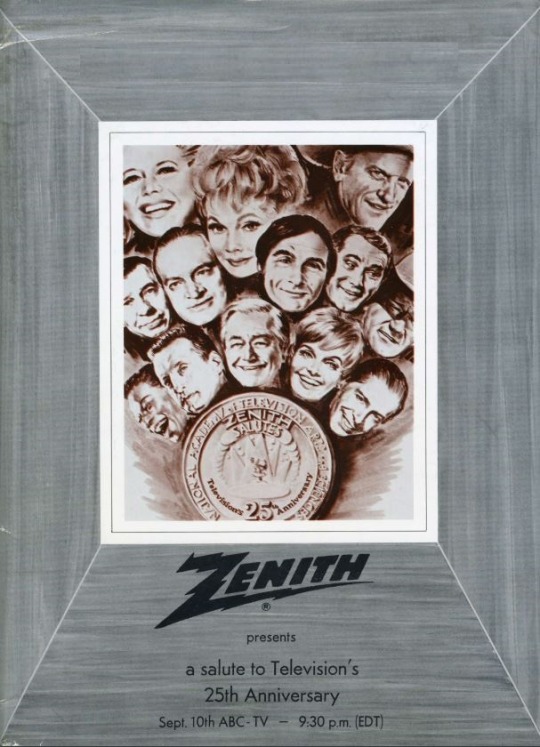
Produced
& Directed by Marty Pasetta
Written
by John Bradford, Lenny Weinrib, Bob Wells

Cast
(in
alphabetical order)
- Judith
Anderson, honoree accepting for “Hallmark Hall of Fame” - Russell
Arms, performer “Hit Parade” - James
Arness, honoree accepting for “Gunsmoke” - Lucille
Ball, honoree - Milton
Berle, honoree - Sid
Caesar, honoree - George
Chakiris, performer “Westerns” / “Crime Drama” - Maria
Cole, honoree on behalf of her late husband, Nat King Cole - Edward
M. Davis, honoree accepting for Jack Webb and “Dragnet” - Jimmy
Durante, performer / presenter “Music and Variety” - Dave
Garroway, honoree and presenter - Lorne
Greene, honoree accepting for “Bonanza” - Florence
Henderson, performer “How Sweet it Was” - Bob
Hope, honoree - Snooky
Lanson, performer “Hit Parade” - Gisele
MacKenzie, performer “Hit Parade” - Dewey
Murrow, honoree accepting for his brother, Edward R. Murrow - Harry
Reasoner, presenter “News” - George
C. Scott, presenter “Drama” - Rod
Serling, presenter - Dinah
Shore, honoree - Tom
& Dick Smothers, performers - Ed
Sullivan, honoree - Eileen
Wilson, performer “Hit Parade” - Robert
Young, presenter “Opening” / “Closing” - John
Wayne, presenter “Westerns” - Efrem
Zimbalist Jr., presenter “Crime Drama”
Dick
Tufeld, Announcer
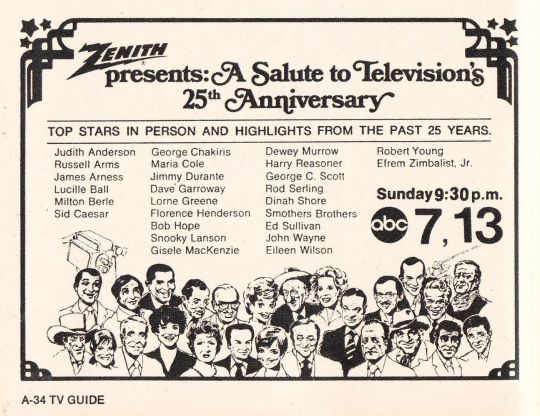
This was a 90-minute special on ABC TV. It was taped August 9 to August 12 in Los Angeles. It featured clips from show’s from television’s past.

Zenith
was co-founded in 1918 by Ralph Matthews and Karl Hassel as Chicago Radio Labs. The name “Zenith” came from ZN’th, a contraction of
its founders’ ham radio call
sign,
9ZN. The Zenith Radio Company
was
formally incorporated in 1923.
LG
Electronics
acquired
a controlling share of Zenith in 1995, becoming a wholly owned
subsidiary in 1999. Zenith was the inventor of subscription
television
and
the modern remote
control,
and the first to develop High-definition
television
(HDTV)
in North
America.
In his diaries, singer Perry Como mentions jetting to Las Vegas to appear on the show, but he is not in the cast nor is he mentioned as an honoree.

The next night, Monday, September 11, on CBS, “Here’s Lucy” presented its fifth season premiere “Lucy’s Big Break” (HL S5;E1).

“Here’s Lucy’s” lead-in was the 18th season premiere of “Gunsmoke” starring James Arness.

“Gunsmoke’s” competition on NBC was “Rowan and Martin’s Laugh-In” which that night started its sixth season with guest star John Wayne. This is very ironic, considering that this Zenith special features a promo that John Wayne did for “Gunsmoke” when it first premiered in 1955!
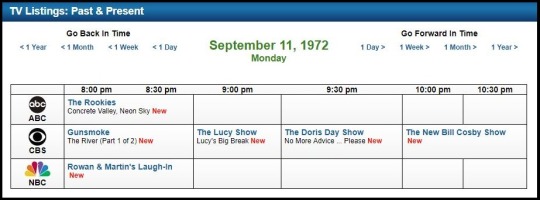
This was a busy night for television, with the series premiere of “The Rookies” (1972-76) on ABC. At 10pm CBS also presented the premiere of “The New Bill Cosby Show,” which lasted just one season.
The
show begins with a boy named John Joyce (played by uncredited actors of
various ages) who grew up watching television.

After
the opening credits, Florence
Henderson
performs the seven-minute opening number “How Sweet It Was,”
surrounded by dancers. The original song was written by Jack Elliott,
Bob Wells and John Bradford. In a section devoted to children’s
shows, the dancers perform “The Mickey Mouse Club” theme, dressed
in mouse ears and sweaters with names on them.

Robert
Young (”Marcus Welby”) takes
the stage to explain that the Academy of Television Arts and Sciences
is also 25 years old and will be honoring a select group of people
and programs who have made an impact, had popularity, proved
longevity, and demonstrated substance. The recognition award is a
silver medallion on a plaque.
A
montage of clips from news footage of the Berlin Airlift, the Israeli
War, the first Political Convention on TV, and the Kefauver Hearings,
and the McCarthy Hearings, follows.
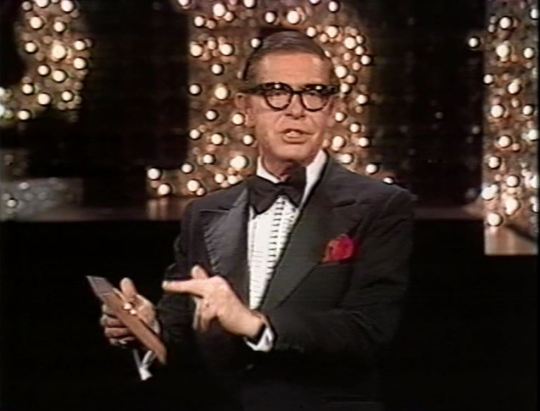
Young
pays tribute to television’s early comedians with clips of such
comics as Jimmy Durante, Martin and Lewis, “The Honeymooners,”
and and ending with clips from “Texaco Star Theatre” starring
Milton
Berle
wearing various outrageous costumes.Berle is the first recipient of the medallion. He enters to thank the audience and briefly talk about his type of comedy.
Berle claims to have done 641 hours of live television!
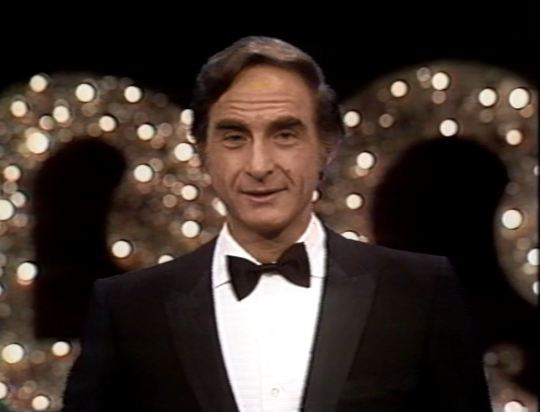
Berle closes by introducing a
clip from “Your Show of Shows” starring Sid
Caesar
and Imogene Coca as figures on a Bavarian clock. Caesar takes the
stage to thank the Academy for the medallion. His remarks are humble
and brief.

After
a commercial for Zenith Super Chromacolor, there is a tribute to TV
dramas with a montage of clips from anthology shows like “The Alcoa
Hour,” “Dupont Show of the Week,” “Westinghouse Studio One,”
“The U.S. Steel Hour,” “Playhouse 90,” “Hallmark Hall of
Fame,” “Goodyear Playhouse,” “Producer’s Showcase,” and
“Net Playhouse.” The clips feature actors like Robert Preston,
Andy Griffith, Jackie Gleason, and Paul Newman.

George
C. Scott enters
to talk about the contributions of “The Hallmark Hall of Fame.”
Clips from the show feature actors like Charlton Heston, Peter
Ustinov, George C. Scott, and Dame
Judith Anderson,
who accepts a medallion on behalf of the show.

A
salute to TV Westerns begins with a stylized Old West town with a
handsome stranger (George
Chakiris),
riding into town on a white horse. Entering the saloon, he plays
cards with a man in black, listens to Lily the dance hall girl, and
then gets into a shoot out where (naturally) he is the only one left
standing.
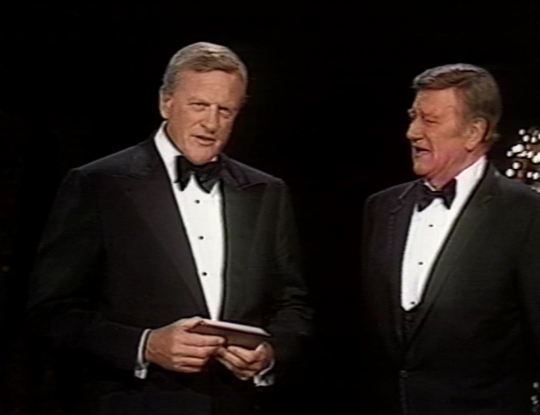
After the sketch, John
Wayne
introduces clips from westerns like “The Lone Ranger,” “Cheyenne,
” “Bonanza,” and “Gunsmoke.” James
Arness, who
played Marshall Dillon on “Gunsmoke,” joins Wayne onstage to
receive a medallion on behalf of the show.
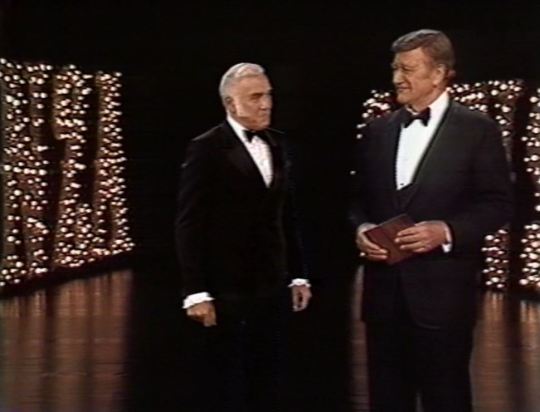
Lorne
Greene then accepts a medallion on behalf of “Bonanza.”
A
salute to TV crime dramas begins with a stylized city street with a
handsome stranger (George Chakiris again), riding into town in a
white sports car. The scenario deliberately mirrors the previous one
for westerns. Entering the bar, he listens to Sally the burlesque
dancer, and gets into a shoot out with a man in black where
(naturally) he is the only one left standing.

After the sketch, Efrem
Zimalist Jr. (“The
F.B.I.”) introduces some ‘fast moving scenes’ from crime shows
like “Hawaii Five-O” and (oddly) “Batman.” Zimbalist pays tribute to
Jack
Webb
and the series “Dragnet.” Accepting the medallion on behalf of
Webb is Los Angeles Police Commissioner Edward
M. Davis.
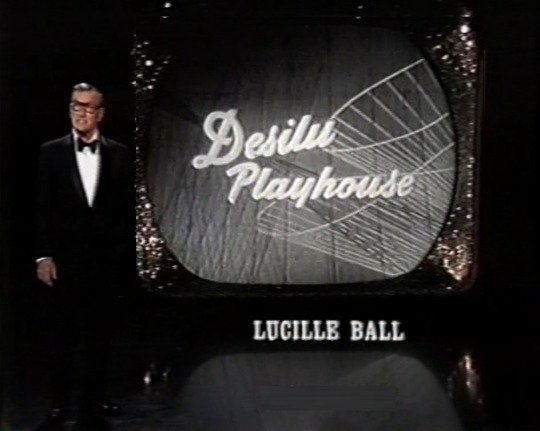
Dave
Garroway (“Today”)
tells us that there are 121 recipients of the silver anniversary
medallion, and that there is no way a 90-minute program can
adequately pay tribute them all. Behind him is a scroll of names and
clips from the honorees, including Lucille
Ball and “The Desilu Playhouse.”
Interestingly, for the sake of continuity, all the clips are in black
and white, even if a show was aired in color.
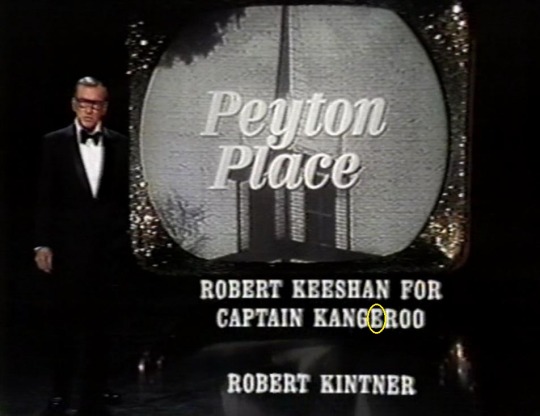
Oops!
The list of honorees mis-spells “Captain Kangaroo” as “Captain
Kangeroo.”
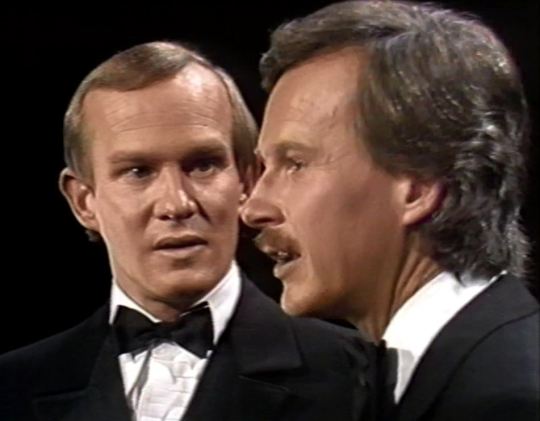
The
Smothers Brothers,
Tom and Dick, talk about television, although Tom has trouble not
mentioning its many flaws, despite Dick’s attempt to keep things
positive.
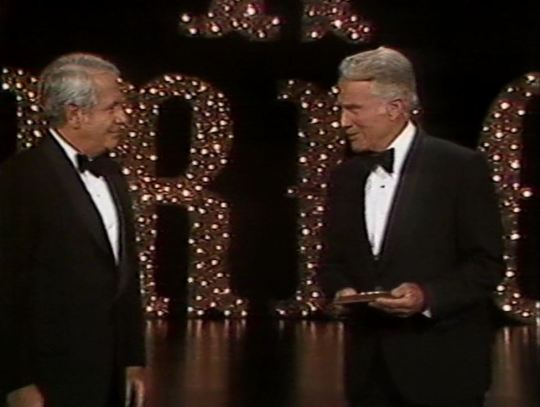
Harry
Reasoner
talks about television news and tributes Edward R. Murrow. Clips
consist of Murrow interviewing such figures as Castro, Marilyn
Monroe, and John F. Kennedy. Murrow died in 1965, so his brother
Dewey
Murrow accepts
the medallion on his behalf.

Leading
off a tribute to music on television is presented in the style of
“Your Hit Parade”:
- #5
– “Shrimp Boats” sung by Eileen
Wilson. It
was written
in 1951 by Paul
Mason Howard
and
Paul
Weston. - #3
– “(Why Did I Tell You I Was Going To) Shanghai” sung by Russell
Arms.
It was written in 1951 by
Bob
Hilliard and
Milton
De Lugg. - Extra
– “Love is Sweeping the Country” performed by the Hit
Parade Dancers. It was written by George
and Ira Gershwin for the
1931 musical Of
Thee I Sing. - #2
– “(How Much is That) Doggie in the Window?” sung by Giselle
MacKenzie (above).
It
was written
by Bob
Merrill
in
1952. - #1
– “This Ole House” sung by Snooky
Lanson.
It was written by
Stuart
Hamblen
in 1954.
Curiously, there is no #4, perhaps for time limitations or because there are only four alumni of “Your Hit Parade” in the show.
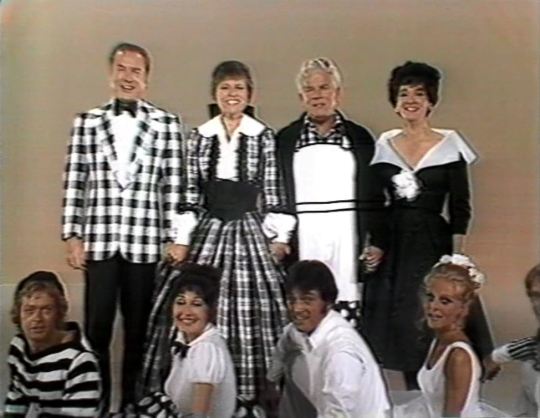
Closing
the section, the group sings “So Long for a While,” the closing song of “Your Hit Parade” written by Hy Zaret.

Jimmy
Durante
enters at the end of the sequence to tribute Music and Variety on
television. It begins with a montage that features Steve Allen,
Liberace, Durante, Edgar Bergen, and Dinah
Shore,
who is the next honoree. Dinah talks about her work on “The Chevy
Show.”

Dinah
Shore:
“We
were live and our main motivation was fear!”
Shore
then tributes the late Nat King Cole, and introduces Maria
Cole,
his widow. “The Nat King Cole Show” (1956) was the first
television show starring a black man.

Durante
returns and sings “September Song” by
Kurt
Weill
and
Maxwell
Anderson for the
1938 musical
Knickerbocker
Holiday.
After
a commercial, Rod
Serling (“The
Twilight Zone”) presents a medallion to ‘Mr. Sunday Night’ Ed
Sullivan.
Clips from “Toast of the Town” (aka “The Ed Sullivan Show”) feature Julie Andrews, the Beatles, Rocky Marciano, and President
Eisenhower.
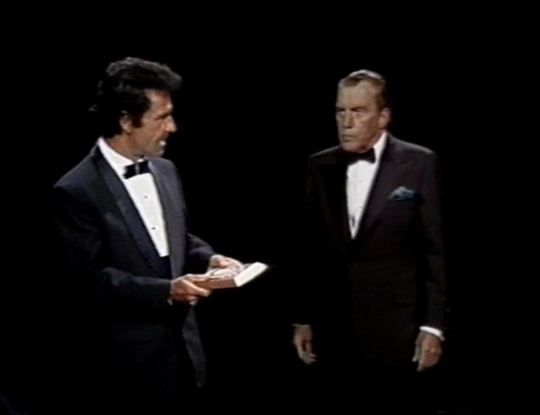
When
Ed
Sullivan
enters to accept his medallion, it is apparent that he is
not on the same stage with Serling, but has been inserted into the
shot using special effects. When Serling hands him the award, the
camera switches to a close-up to avoid the transfer.
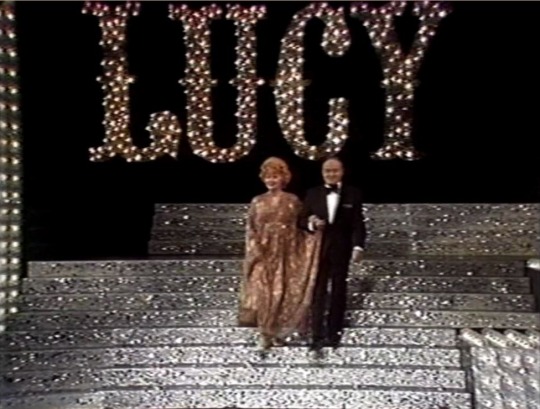
Serling
also presents medallions to Lucille
Ball and
Bob
Hope.
A brief montage of clips from “I Love Lucy” and various Bob Hope
specials follows. It includes scenes from “The Audition” (ILL
S1;E6), “The Operetta” (ILL S2;E5), “Lucy Meets Harpo Marx”
(ILL S4;E28). Interestingly, there are no clips of the two performing
together.
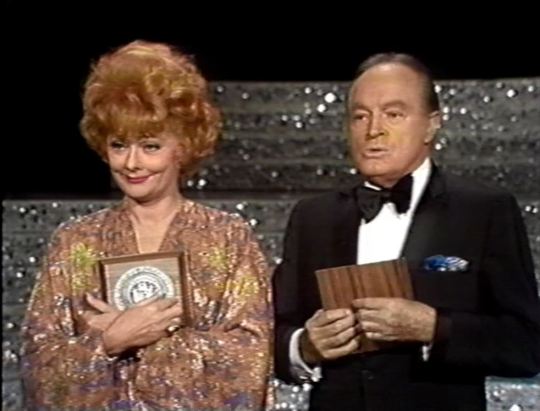
Once
again, it is apparent that Serling is not on the same stage as Lucy
and Bob, despite the fact that they address him as if he were there standing beside him.
This time there is no special effect to imply they are together.
Hope calls him the “spooky writer” and Lucy refers to Serling’s
voice on “headache commercials.” Hope and Ball exchange some
friendly banter based on their age:
Lucy:
“I
just love watching ‘The Late, Late Show’. Where else could I be 25
for 25 years?“
Bob:
“On
your reruns. You know I’m kidding, Lucy. You’re the most beautiful
woman in Hollywood and you have been for many years.”
Lucy:
“That’s
quite a compliment considering you started as a stuntman for Francis
X. Bushman.”
The
show closes with the singers and dancers reprising “How Sweet It
Was” and Robert Young returning to sum up television’s progress and promise for the future.
This time the clips behind him are in color. A montage of
‘good nights’
from various television shows plays under the credits.
This
Date in Lucy History ~ September 10

“Lucy
and Danny Thomas” (HL S6;E1) ~ September 10, 1974
Leave a comment